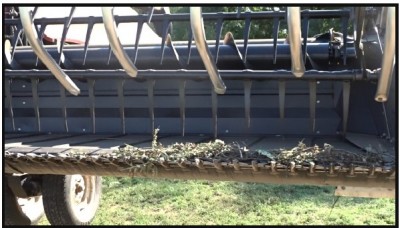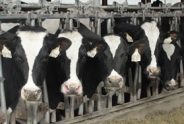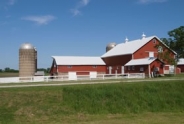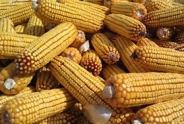Recommended Procedures for a Between-field Combine Clean-out

By: Meaghan Anderson, Iowa State University Extension; Kevin Jarek, University of Wisconsin-Madison Extension; Angie Johnson, North Dakota State University Extension; Wayne Ohnesorg, University of Nebraska-Lincoln Extension; Mark Hanna, Iowa State University
An Ounce of Prevention is Greater than 150 Pounds of Unwanted Biomaterial
Combines are one of the largest and most impressive machines on a farm. These large machines effectively remove crops from fields and separate grain from other material to be spread back in the field. Following harvest of an individual field, combines retain significant material. As much as 150 pounds of biomaterial is retained, including chaff, grain, and weed seed. This material may remain in tight spaces within the machine or in obvious places, such as the gathering head and grain tank.
While it is impossible to remove all material from a combine, effort following the harvest of fields can be valuable in reducing movement of weed seed and other material from one field to another. Most farmers can point to fields with specific problems that other fields do not have, such as burcucumber, Palmer amaranth, or other difficult-to-manage issues like herbicide-resistant weeds. Sanitation and appropriate combine clean-out when working with these fields should be a top priority to prevent spread of issues.
Priorities to Prevent Spreading Weed Seed
To reduce the movement of issues from one field to another, farmers should take care to do three steps, whenever possible:
1. Remove problem weeds prior to harvest to prevent contamination of combine
2. Consider harvest order to prevent carrying seed of problem weeds to currently clean fields
3. Practice good clean-out procedures prior to moving to clean fields
Combine Clean-out Essentials
Cleaning out the combine prior to moving from one field to another may not be practical in all cases but is an essential step to limit potential of weed problems moving from one field to another during harvest. A full clean-out may be impractical due to the time constraints of cleaning the complex interior of a combine. However, farmers should focus on priority areas where significant material may remain and be knocked loose in following fields.
Personal Protective Equipment (PPE)
When preparing to conduct a clean-out of a combine, personal protective equipment should be worn. PPE necessary for this clean-out includes gloves, protective eyewear, a dust mask with at least an N95 rating, and hearing protection.
20-30 Minute Cleaning Steps
Whether you operate a red, green, or yellow combine unit, a brief 20 to 30 minute cleaning commitment will remove some of the material that may easily come loose later in the field. Priorities for this cleaning should include:
1. Run unloading auger empty for at least one minute (Figure 3).
2. Open the clean grain and tailings elevator doors, rock trap, and unloading auger sump (Figure 4).
a. Make sure all bystanders are at least 50 feet away.
b. Optional: Remove the header from the combine prior to self-cleaning.
3. Start the combine and separator.
a. Adjust cleaning shoe fan to full speed for maximum airflow and alternately open and close cleaning shoe sieves electronically
b. Adjust rotor to full speed for maximum air suction and alternately open and close concaves.
4. Operate the combine this way for at least two minutes for self-cleaning
a. Optional: Drive over end rows or rough terrain to dislodge material during operation.
5. Clean any material left in the rock trap (Figure 5).
6. Use a leaf blower or air compressor to remove material from exterior of the combine, focusing on the head, feederhouse, and axle and straw spreader at the rear of the machine (Figure 6).
7. Remember to close the doors to the rock trap, clean the grain elevator, and the unloading auger sump.
Summary
This clean-out procedure will not reduce the importance of practicing weed control tactics like removing weeds prior to harvest or choosing harvest order to prevent cross-contamination of fields. It will reduce movement of material and weed seed to fields harvested later in the season. At the end of the harvest season, a full combine clean-out should be completed for maintenance of the machine.
Between Field Combine Cleanout (pdf; 970KB)
Upcoming Events
Memoir Reading: Barn Gothic
December 4, 2025
Bath, NY
Barn Gothic is an elegy for family farmers and an intimate portrait of three generations laboring to be fathers and sons while their livelihood falls apart. Beautifully told with a farmer's restraint and a poet's grace, it is a story of personal loss amid corporate corruption and of finding a way forward when everything you know disappears.
NY Small Farms Summit 2025: Stronger Together
December 5, 2025
Alfred, NY
We hope you will join us on December 5th for the 2025 New York Small Farms Summit! This is an opportunity to meet other farmers and ag supporters, learn about research and education projects, and set priorities for future efforts to grow small farm success.
At the Allegany County site, we will focus on giving trees a chance and how trees build resiliency on small farms. Whether attracted to fruit, nuts, vegetables, fodder or shade, trees can be an integral part of a successful farming system. Join us as we explore the opportunities for resiliency that come from adding tree crops or managing wooded areas of your farm for agroforestry or silvopasture systems.
Crops, Cows & Critters - Southwest New York Dairy, Livestock & Field Crops Newsletter Sponsorship
December 19, 2025
Our two forms of publications feature research-based and timely information from our four specialists, listed to the right, along with local event notifications and Cornell University outreach. This information is provided to participants who range from dairy, livestock, and field crops producers to agricultural suppliers and consultants.
Weekly Email Update: Shared with 625+ households who have signed up with our program.
Monthly Paper Mailer: To reach our stakeholders and farmers who lack internet access, we send out a monthly mailer where your company's logo and contact information would be featured with a mailing list of 330+ households.
If you sponsor our weekly and monthly publications you reach approximately 955 households.
Visit our website to view our newsletters!
Announcements
No announcements at this time.





